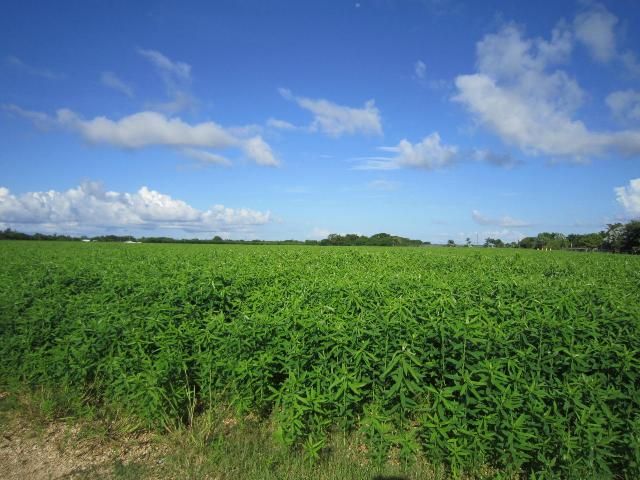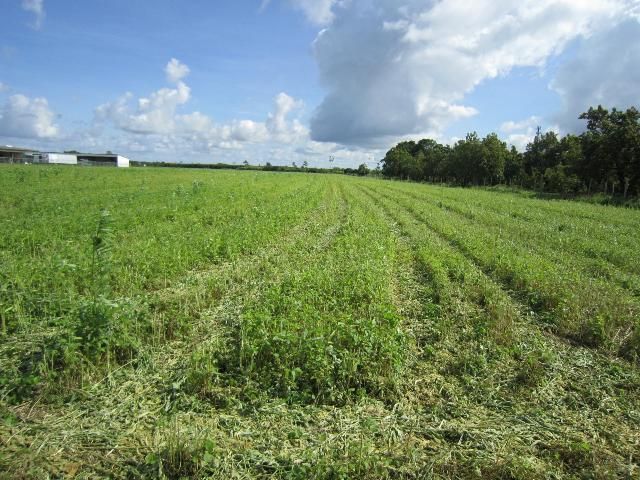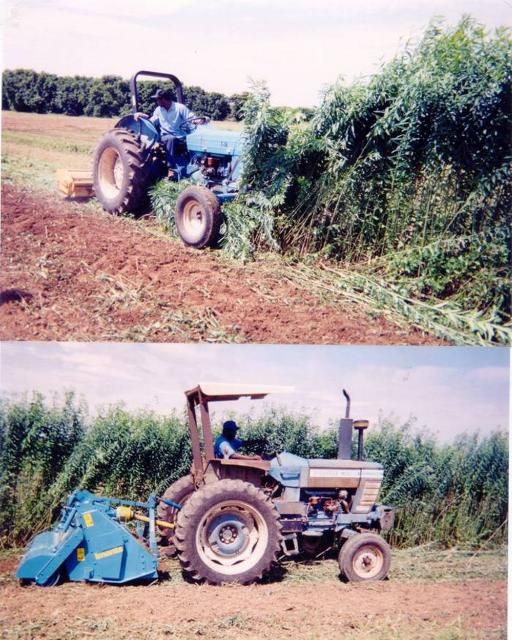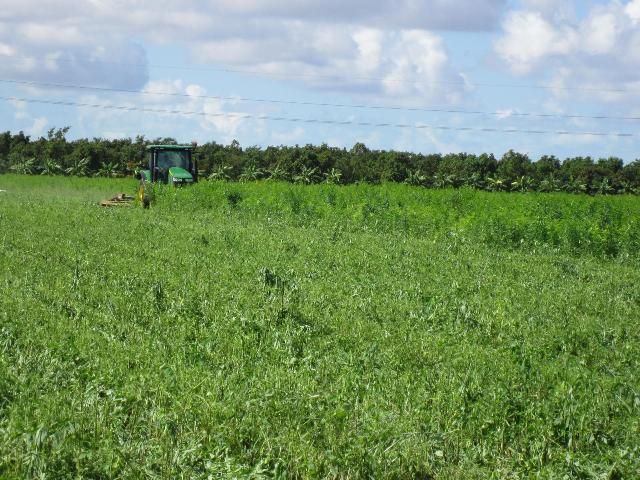Abstract
As one of the promising cover crops under tropical, subtropical, or even template climate, sunn hemp (Crotalaria Juncea L.) has shown great advantages in improving soil fertility and increasing the yield and quality for subsequent cash crops. Due to the leguminous feature, sunn hemp can grow well in the soil with poor fertility, grow fast, accumulate a significant amount of nitrogen from soil, suppress weeds and soil root-knot nematodes, and tolerate dry and wet environmental conditions. Therefore, this article aims to elucidate unique features, origin, plant growth, handling, potential benefits, and the limitation in seed production of sunn hemp. It provides basic information to growers, stakeholders, and anyone interested in growing cover crops for crop rotation to optimize the cropping systems for sustainable agriculture.
Scientific Name: Crotalaria juncea L.
Family: pea family (Fabaceae).
Common Name: Sunn hemp, Indian hemp, Madras hemp, brown hemp, and sann hemp
Common Variety: 'Tropic Sun,' jointly released in 1982 by the University of Hawaii and the Soil Conservation Service, USDA
Origin and Distribution: Sunn hemp is native to India and Pakistan originally as a fiber crop. In Southeast Asia, sunn hemp has been grown as a green manure crop for centuries and now is cultivated in many tropical and subtropical regions worldwide. Sunn hemp seeds are mainly produced in India, Hawaii, Colombia, and South Africa. In the US, this plant has been grown as a summer cover crop in the southern, Mid-Atlantic, Pacific, and northern Great Plains states. Flowering is triggered by short daytime length, but an appropriate temperature is required for full seed set. Therefore, sunn hemp cannot produce seed commercially in most US states except Hawaii. Under Miami or south Florida climate, sunn hemp can make profuse flowers, but seed setting is very limited due to the inappropriate temperature associated with the daytime length.
Description of Plant: Sunn hemp is a short-day, herbaceous annual, with erect fibrous ridged stems. The leaves are simple, up to 5 inches long and up to 1.4 inches wide, oblong lance-like in shape, covered with short, downy hairs, and arranged spirally along the stem. The plant has a strong taproot with well-developed lateral roots. It forms lobed nitrogen-fixing nodules that are colonized by cowpea-type rhizobia on the roots. The plants branch at approximately 20 inches above the ground when not crowded, but branching is suppressed in dense stands. When grown under short daytime lengths, flowering occurs about eight weeks after seeding. In Homestead, Florida, when sunn hemp is seeded in May, the plant's showy bright yellow flowers bloom profusely beginning in early September. When the plants are flowering, the plant has reached its maximum size and the stems will become fibrous. Therefore, if growing sunn hemp as a cover crop, cut or ratoon the plants prior to flowering for the maximum quantity and better quality of biomass.
Uses: Sunn hemp is well suited for use by winter fresh market vegetable producers in Florida as a green manure or cover crop to provide both organic matter and nitrogen during the period of the long summer. Since sunn hemp can produce significant quantities of biomass and nitrogen in as little as 6 weeks after seeding, it can readily fit into short-rotation sustainable production systems in Florida. When seeded in spring or early summer in Homestead, Florida, sunn hemp grows to a height of 7 feet and covers the land completely (canopy closure) in about ten weeks. No other cover crop is known to grow so rapidly in this region. However, when seeded during a period with short day lengths, the plant may grow only 3 to 4 feet tall and bloom. To obtain high yields of biomass in Florida, sunn hemp should be seeded in April through June and not later than mid-July. Since this plant is a legume, sunn hemp supplies its own nitrogen and provides residual nitrogen to the subsequent crop. Furthermore, sunn hemp can be grown as high-quality forage. However, since livestock do not eat sunn hemp plants when green, sunn hemp should be harvested for hay. In India, clothing, twine, and rope are made from the fiber of old, densely grown sunn hemp plants. In some areas, seeds are fed to pigs and horses without adverse effects. However, since some sunn hemp varieties contain moderately toxic levels of pyrrolizidine alkaloids, sunn hemp fodder and seeds are usually provided as no more than 45% of the feed ration of ruminants, swine, and horses. In India, sunn hemp is still mainly grown as a fiber crop.
Via atmospheric nitrogen fixation, sunn hemp may accumulate more than 200 pounds of nitrogen per acre. This crop also adds 2.5 to 4 tons of organic matter when incorporated into the soil. When environmental conditions are optimal and with appropriate ratoon techniques, as much as 7 tons of aboveground fresh biomass and 320 pounds of nitrogen per acre can be accumulated in subtropical regions, such as south Florida (Figure 1). To grow sunn hemp in subtropical regions, seeds should be sown at a soil depth of ¾–1 inch. At greater seeding depths, emergence and establishment will be affected. Seeds should be sown in soil temperatures greater than 68°F for successful germination. Seeds usually germinate readily within 3 days, and seedlings rapidly develop a dense ground cover. To establish as a cover crop, sunn hemp should be sown at a rate of 10 to 40 pounds of seed per acre. Lower seeding rates can promote lateral branching. Seeds can be inoculated with cowpea inoculant to improve rhizobium development for nitrogen fixation.

Credit: Qingren Wang, UF/IFAS
In field trials at Homestead, Miami-Dade County, sunn hemp was seeded together with velvetbean (3 pounds per acre of sunn hemp and 30 pounds per acre of velvetbean), sunn hemp served as a trellis to support vines of velvetbean and to strongly suppress weeds through shading. Velvetbean in combination with sunn hemp produced more than twice the amount of biomass compared to pure velvetbean stands. In addition, when used as a trellis, sunn hemp performed better than corn, which had to be sprayed repeatedly to protect it from insects and diseases.
Production and Harvest: Sunn hemp grows well at mean annual air temperatures from 70 to more than 100°F. High temperature with moderate humidity is preferable for sunn hemp growth and development. Growth may be slowed by cool weather, and the plant is susceptible to freezing injuries when the temperature is less than 28°F. Although sunn hemp tolerates poor fertility soils and no fertilization is necessary, its productivity is enhanced on fertile soils. Sunn hemp can grow well in soils with pH ranging from 5.0 to 8.4. This plant is adapted to well-drained calcareous soils and acidic sandy soils; it can tolerate a short time and moderate flooding but not waterlogged or saline/sodic soils. Sunn hemp is drought tolerant and, generally, no irrigation is necessary during the hot and humid summer in south Florida. Nevertheless, in Miami-Dade County, studies have shown that irrigation just before and after seeding can improve the germination and establishment.
Sunn hemp plants do not need to be mowed during the middle of summer if fibrous stems are not formed. However, to avoid the formation of fibrous stems, ratooning (cutting to let it grow again) can promote biomass quantity and quality. For example, in a field experiment at Homestead, Florida, in which 5-foot-tall plants were ratooned at 1 foot, 2 feet, and 3 feet above the ground and then allowed to grow 70 more days, the total yields of dry biomass were 8.3, 11.0, and 13.8 tons per acre, respectively, compared to 11.4 tons per acre in the uncut control. The corresponding amounts of nitrogen in the biomass were 259, 255, and 277 pounds, respectively, compared to 238 pounds of nitrogen in the uncut control. Ratooning the main stem and thereby destroying the dominance of the apical buds can induce profuse branching and the production of additional leaves and flowers. Sunn hemp roots, stems, and branches are fibrous with high cellulose and low nitrogen content, whereas leaves and flowers are rich in nitrogen. When the leaves and flowers are incorporated into the soil, they are readily mineralized. The combined dry weights of leaves and flowers in the above experiment were 2.7, 2.0, and 1.7 tons per acre in plants cut at 1 foot, 2 feet, and 3 feet above the ground, respectively, compared to the 1.7 tons per acre in the uncut control. Further, the amounts of nitrogen in the leaves and flowers were 192, 147, and 132 pounds per acre in plants cut at 1 foot, 2 feet, and 3 feet above the ground, respectively, compared to the 122 pounds per acre in the uncut control.
In the above experiment, the greatest amount of biomass and nitrogen was obtained by cutting the main sunn hemp stems at 3 feet above the ground, whereas the greatest amounts of leaves and flowers were produced when the stems were cut at 1 foot above the ground. Therefore, mowing at 1 foot above the ground would be beneficial if high quality biomass is desired for production of a vegetable crop or for use as hay.
Ratooning sunn hemp plants at less than 1 foot may result in plant mortality. Regrowth of ratooned plants requires at least 10 leaves remain on each plant (Figure 2). Since the lower leaves tend to become senescent and drop off as the plant matures, the cutting height should be higher in more mature stands than in young stands. With long day lengths, relatively early cutting facilitates regrowth and high yields. However, with short day lengths, the time of cutting has some effect on biomass yield. In addition, the ideal equipment for ratooning sunn hemp is a sickle bar driven by tractor. The use of circular mowers with dull blades or poorly adjusted flail mowers are likely to kill many sunn hemp plants. A dull blade or flail knife will cause the stem fibers to tear down to the base of the plant, usually resulting in loss of some plants.

Credit: Qingren Wang, UF/IFAS
The plant should be plowed down when flower buds have formed or during the early flowering stage (Figure 3). Mowing and disking are common practices to incorporate the plant residues into the soil (Figure 4). For example, to follow sunn hemp with vegetables and to take advantage of the nitrogen present in the sunn hemp biomass, the plant should be incorporated into the soil within 60 days of planting a vegetable crop. This practice ensures sufficient sunn hemp decomposition to supply nitrogen to the following crop.

Credit: Y. C. Li, UF/IFAS

Credit: Qingren Wang, UF/IFAS
Several insect species may attack sunn hemp, but usually they do not cause substantial economic losses that justify chemical treatment. However, sunn hemp grown in wet soil is susceptible to Pythium spp. and Fusarium spp., which may cause significant yield losses. Therefore, good soil drainage is necessary to obtain adequate biomass production. In addition, since sunn hemp is resistant to soil root-knot and soybean cyst nematodes, adding sunn hemp to the crop rotation system with nematode-susceptible cash crops may substantially benefit these cash crops by lowering nematode pressure (carryover effect). Another benefit of sunn hemp in subtropical areas is its rapid growth. Therefore, sunn hemp can effectively control weeds during the summer months. This crop also supplies the added benefits of soil erosion prevention and windbreaks for vegetable and tropical fruit crops due to its denseness and height. The sensitivity of sunn hemp plants to herbicides has yet to be studied.
Seed Production: Shortages of seed from local suppliers used to limit the use of sunn hemp. Currently, the cost of seed is about $1.50 per pound. Seed is mainly imported from tropical countries, e.g., India, South Africa, and Columbia, and limited amounts are supplied from Hawaii. Seed production is more difficult in the subtropics than in the tropics. Long day lengths and cool temperatures are the major factors limited local seed production in Florida. In the tropics, flowering can begin at six weeks after planting, and seed maturity is reached at four months or more. Worldwide, seed yields range from 400 to 900 lb per acre. It should be possible to increase yields by cutting the main stem at 3 feet above the ground or higher to induce more branches and flowers. There are approximately 15,000 seeds per pound. Seeds remain viable for years if properly stored at low-temperatures. Currently a study is underway to evaluate sunn hemp seed production potential in South Florida. We expect that seed production can be improved in this subtropical region to supply local seed demands in the future.
For More Information
Abdul-Baki, A. A., H. H. Bryan, G. M. Zinati, W. Klassen, M. Codallo and N. Heckert. 2001. "Biomass yield and flower production in sunn hemp: Effect of cutting the main stem." Journal of Vegetable Crop Production. 71(1): 83–104.
Schomberg, H. H., N. L. Martini, J. C. Diaz-Perez, S. C. Phatak, K. S. Balkom and H. L. Bhardwaj. 2007. "Potential for using sunn hemp as a source of biomass and nitrogen for the Piedmont and Coastal Plain Regions of the southeastern USA." Agronomy Journal. 99: 1448–1457.
Li, Y.C., E. Hanlon, W. Klassen, Q. Wang, and T. Olczyk. 2006. Cover Crops Benefits and Selection for Commercial Vegetable Producers. Gainesville: University of Florida Institute of Food and Agricultural Sciences. SL-242. https://edis.ifas.ufl.edu/publication/ss461
Treadwell, D.D. and Mike Alligood. 2008. Sunn Hemp (Crotalaria juncea L.): A Summer Cover Crop for Florida Vegetable Producers. Gainesville: University of Florida Institute of Food and Agricultural Sciences. https://edis.ifas.ufl.edu/hs1126